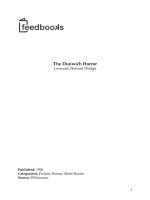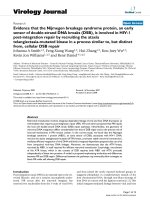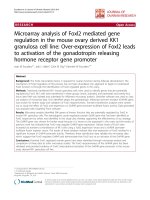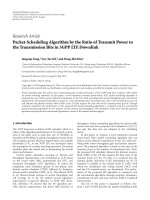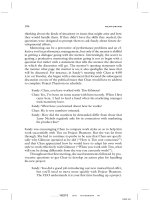The Dancing Mouse, by Robert M. Yerkes pptx
Bạn đang xem bản rút gọn của tài liệu. Xem và tải ngay bản đầy đủ của tài liệu tại đây (1.41 MB, 806 trang )
The Project Gutenberg EBook of The
Dancing Mouse, by Robert M. Yerkes
Copyright laws are changing all over the
world. Be sure to check the copyright
laws for your country before downloading
or redistributing this or any other Project
Gutenberg eBook.
This header should be the first thing seen
when viewing this Project Gutenberg file.
Please do not remove it. Do not change or
edit the header without written
permission.
Please read the "legal small print," and
other information about the eBook and
Project Gutenberg at the bottom of this
file. Included is important information
about your specific rights and restrictions
in how the file may be used. You can also
find out about how to make a donation to
Project Gutenberg, and how to get
involved.
**Welcome To The World of Free Plain
Vanilla Electronic Texts**
**eBooks Readable By Both Humans and
By Computers, Since 1971**
*****These eBooks Were Prepared By
Thousands of Volunteers!*****
Title: The Dancing Mouse A Study in
Animal Behavior
Author: Robert M. Yerkes
Release Date: August, 2005 [EBook
#8729] [Yes, we are more than one year
ahead of schedule] [This file was first
posted on August 4, 2003]
Edition: 10
Language: English
*** START OF THE PROJECT
GUTENBERG EBOOK THE DANCING
MOUSE ***
Produced by Juliet Sutherland, Michael
Oltz, Charles Franks and the Online
Distributed Proofreading Team.
[Illustration: DANCING MICE—
SNIFFING AND EATING.]
THE ANIMAL BEHAVIOR
SERIES. VOLUME I
THE DANCING MOUSE
A Study in Animal Behavior
BY
ROBERT M. YERKES, Ph.D.
INSTRUCTOR IN COMPARATIVE
PSYCHOLOGY IN HARVARD
UNIVERSITY
The Cartwright Prize of the Alumni
Association of the College of
Physicians and Surgeons, Columbia
University, was awarded, in 1907, for an
Essay which comprised the first twelve
chapters of this volume.
1907
IN LOVE AND GRATITUDE
THIS BOOK IS
DEDICATED TO MY
MOTHER
PREFACE
This book is the direct result of what, at
the time of its occurrence, seemed to be an
unimportant incident in the course of my
scientific work— the presentation of a
pair of dancing mice to the Harvard
Psychological Laboratory. My interest in
the peculiarities of behavior which the
creatures exhibited, as I watched them
casually from day to day, soon became
experiment-impelling, and almost before I
realized it, I was in the midst of an
investigation of their senses and
intelligence.
The longer I observed and experimented
with them, the more numerous became the
problems which the dancers presented to
me for solution. From a study of the senses
of hearing and sight I was led to
investigate, in turn, the various forms of
activity of which the mice are capable; the
ways in which they learn to react
adaptively to new or novel situations; the
facility with which they acquire habits; the
duration of habits; the roles of the various
senses in the acquisition and performance
of certain habitual acts; the efficiency of
different methods of training; and the
inheritance of racial and individually
acquired forms of behavior.
In the course of my experimental work I
discovered, much to my surprise, that no
accurate and detailed account of this
curiously interesting animal existed in the
English language, and that in no other
language were all the facts concerning it
available in a single book. This fact, in
connection with my appreciation of the
exceptional value of the dancer as a pet
and as material for the scientific study of
animal behavior, has led me to supplement
the results of my own observation by
presenting in this little book a brief and
not too highly technical description of the
general characteristics and history of the
dancer.
The purposes which I have had in mind as
I planned and wrote the book are three:
first, to present directly, clearly, and
briefly the results of my investigation;
second, to give as complete an account of
the dancing mouse as a thorough study of
the literature on the animal and long-
continued observation on my own part
should make possible; third, to provide a
supplementary text-book on mammalian
behavior and on methods of studying
animal behavior for use in connection
with courses in Comparative Psychology,
Comparative Physiology, and Animal
Behavior.
It is my conviction that the scientific study
of animal behavior and of animal mind
can be furthered more just at present by
intensive special investigations than by
extensive general books. Methods of
research in this field are few and
surprisingly crude, for the majority of
investigators have been more deeply
interested in getting results than in
perfecting methods. In writing this account
of the dancing mouse I have attempted to
lay as much stress upon the development
of my methods of work as upon the results
which the methods yielded. In fact, I have
used the dancer as a means of exhibiting a
variety of methods by which the behavior
and intelligence of animals may be
studied. As it happens the dancer is an
ideal subject for the experimental study of
many of the problems of animal behavior.
It is small, easily cared for, readily tamed,
harmless, incessantly active, and it lends
itself satisfactorily to a large number of
experimental situations. For laboratory
courses in Comparative Psychology or
Comparative Physiology it well might
hold the place which the frog now holds in
courses in Comparative Anatomy.
Gratefully, and with this expression of my
thanks, I acknowledge my indebtedness to
Professor Hugo Münsterberg for placing
at my command the resources of the
Harvard Psychological Laboratory and for
advice and encouragement throughout my
investigation; to Professor Edwin B. Holt
for valuable assistance in more ways than
I can mention; to Professor Wallace C.
Sabine for generous aid in connection
with the experiments on hearing; to
Professor Theobald Smith for the
examination of pathological dancers; to
Miss Mary C. Dickerson for the
photographs of dancing mice which are
reproduced in the frontispiece; to Mr.
Frank Ashmore for additional photographs
which I have been unable to use in this
volume; to Mr. C. H. Toll for the
drawings for Figures 14 and 20; to
Doctors H. W. Rand and C. S. Berry for
valuable suggestions on the basis of a
critical reading of the proof sheets; and to
my wife, Ada Watterson Yerkes, for
constant aid throughout the experimental
work and in the preparation of this
volume.
R. M. Y.
CAMBRIDGE, MASSACHUSETTS,
August, 1907.
CONTENTS
LIST OF ILLUSTRATIONS
LITERATURE ON THE DANCING MOUSE
CHAPTER I
CHARACTERISTICS, ORIGIN, AND
HISTORY
Peculiarities of the dancing mouse—
Markings and method of keeping record of
individuals—The dancer in China and
Japan (Kishi, Mitsukuri, Hatai)—
Theories concerning the origin of the race:
selectional breeding; the inheritance of an
acquired character; mutation, inheritance,
and selectional breeding; pathological
changes; natural selection—Instances of
the occurrence of dancers among other
kinds of mice—Results of crossing dancer
with other kinds of mice.
CHAPTER II
FEEDING, BREEDING, AND
DEVELOPMENT OF THE YOUNG
Methods of keeping and caring for dancers
—Cages, nest-boxes, and materials for
nest—Cleansing cages—Food supply and
feeding—Importance of cleanliness,
warmth, and pure food—Relations of
males and females, fighting—The young,
number in a litter—Care of young—
Course of development—Comparison of
young of dancer with young of common
mouse— Diary account of the course of
development of a typical litter of dancers.
CHAPTER III
BEHAVIOR: DANCE MOVEMENTS
Dancing—Restlessness and excitability—
Significance of restlessness— Forms of
dance: whirling, circling, and figure-
eights—Direction of whirling and
circling: right whirlers, left whirlers, and
mixed whirlers— Sex differences in
dancing—Time and periodicity of dancing
—Influence of light on activity—
Necessity for prolonged observation of
behavior.
CHAPTER IV
BEHAVIOR: EQUILIBRATION AND
DIZZINESS
Muscular coordination—Statements of
Cyon and Zoth concerning behavior—
Control of movements, orientation,
equilibration, movement on inclined
surfaces, climbing—The tracks of the
dancer—Absence of visual dizziness—
Comparison of the behavior of the dancer
with that of the common mouse when they
are rotated in a cyclostat—Behavior of
blinded dancers (Cyon, Alexander and
Kreidl, Kishi)—Cyon's two types of
dancer— Phenomena of behavior for
which structural bases are sought: dance
movements; lack of response to sounds;
deficiency in equilibrational ability; lack
of visual and rotational dizziness.
CHAPTER V
STRUCTURAL PECULIARITIES AND
BEHAVIOR
The functions of the ear—Structure of the
ear of the dancer as described by Rawitz,
by Panse, by Baginsky, by Alexander and
Kreidl, and by Kishi— Cyon's theory of
the relation of the semicircular canals to
space perception—Condition of the
auditory organs—Condition of the
equilibrational organs—Condition of the
sound-transmitting organs—The bearing
of the results of anatomical investigations
upon the facts of behavior.
CHAPTER VI
THE SENSE OF HEARING
Experiments on hearing in the dancer
made by Rawitz, by Panse, by Cyon, by
Alexander and Kreidl, by Zoth, and by
Kishi—Hearing and the voice—
Methods of testing sensitiveness to sounds
—Results of tests with adults—
Importance of indirect method of
experimentation—Results of tests with
young—The period of auditory
sensitiveness—Individual differences.
CHAPTER VII
THE SENSE OF SIGHT: BRIGHTNESS
VISION
What is known concerning sight in the
dancer—Brightness vision and color
vision—Methods of testing brightness
vision, the visual discrimination apparatus
—Motives for discrimination and choice
—Punishment versus reward as an
incentive in animal experiments—Hunger
as an incentive—An electric stimulus as
an incentive—Conditions for brightness
vision tests— White-black vision—
Evidence of preference—Check
experiments—Conclusion.
CHAPTER VIII
THE SENSE OF SIGHT: BRIGHTNESS
VISION (Continued)
The delicacy of brightness discrimination
—Methods of testing the dancer's ability
to detect slight differences in brightness—
Results of tests with gray papers—
Relation of intensity of visual stimuli to
the threshold of discrimination—Weber's
law apparatus and method of
experimentation— Results of Weber's law
tests—Practice effects, the training of
vision— Description of the behavior of
the dancer in the discrimination box
experiments—Modes of choice: by
affirmation; by negation; by comparison—
Evidence of indiscriminable visual
conditions.
CHAPTER IX
THE SENSE OF SIGHT: COLOR VISION
Does the dancer see colors?—The food-
box method of testing color vision—
Waugh's food-box method—Results of
tests—Tests by the use of colored papers
in the visual discrimination box—Yellow-
red vision—Blue-orange vision—
Brightness vision versus color vision—
Brightness check tests—Green-blue vision
—Violet-red vision—Conclusions.
CHAPTER X
THE SENSE OF SIGHT: COLOR
VISION (Continued)
The use of color filters—Testing color
vision by the use of transmitted light—
Green-blue vision—Green-red vision—
Blue-red vision—Stimulating value of
different portions of the spectrum—Does
red appear darker to the dancer than to us?
—Conclusions concerning color vision—
Structure of the retina of the dancer and its
significance.
CHAPTER XI
THE ROLE OF SIGHT IN THE DAILY LIFE
OF THE DANCER.
Sight and general behavior—Behavior of
blinded dancers—Experimental tests of
ability to perceive form—Visual guidance
in mazes—Following labyrinth paths in
the dark—The relative importance of
visual, olfactory, and kinaesthetic stimuli
—Conditions for the acquisition of a
motor habit—Conditions for the execution
of an habitual act.
CHAPTER XII
EDUCABILITY: METHODS OF LEARNING

